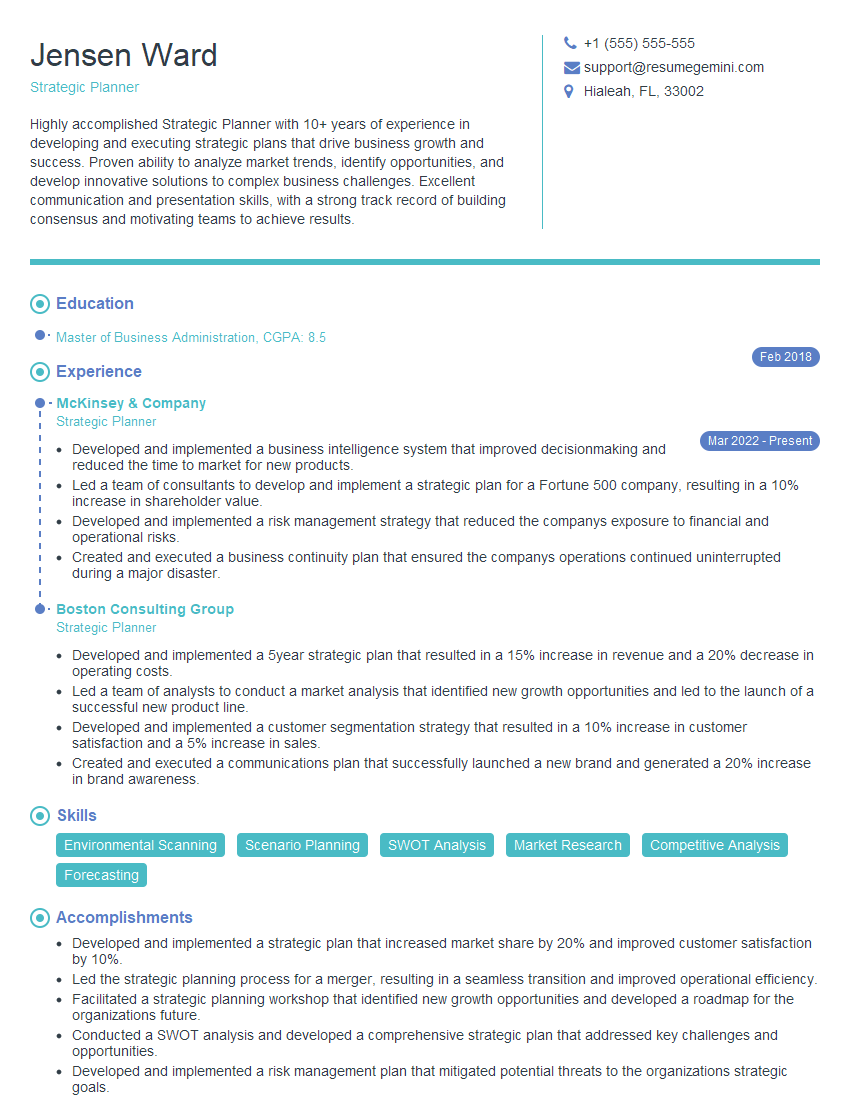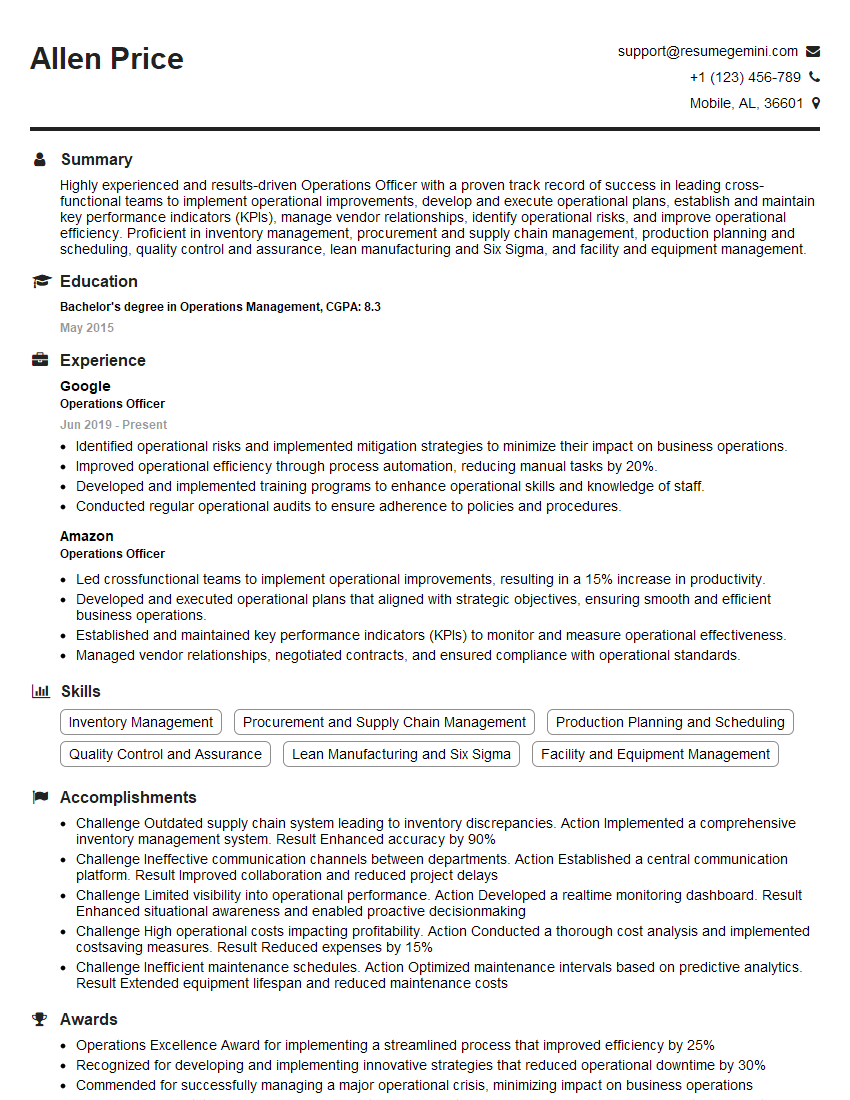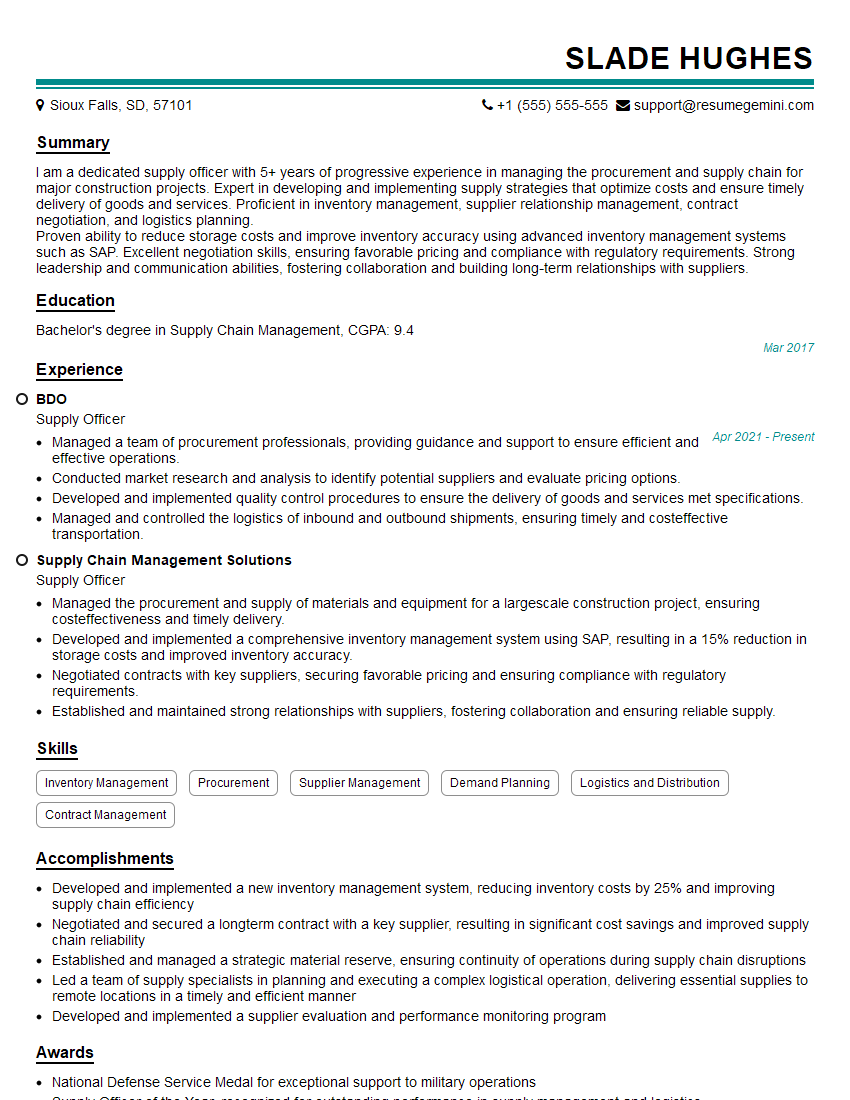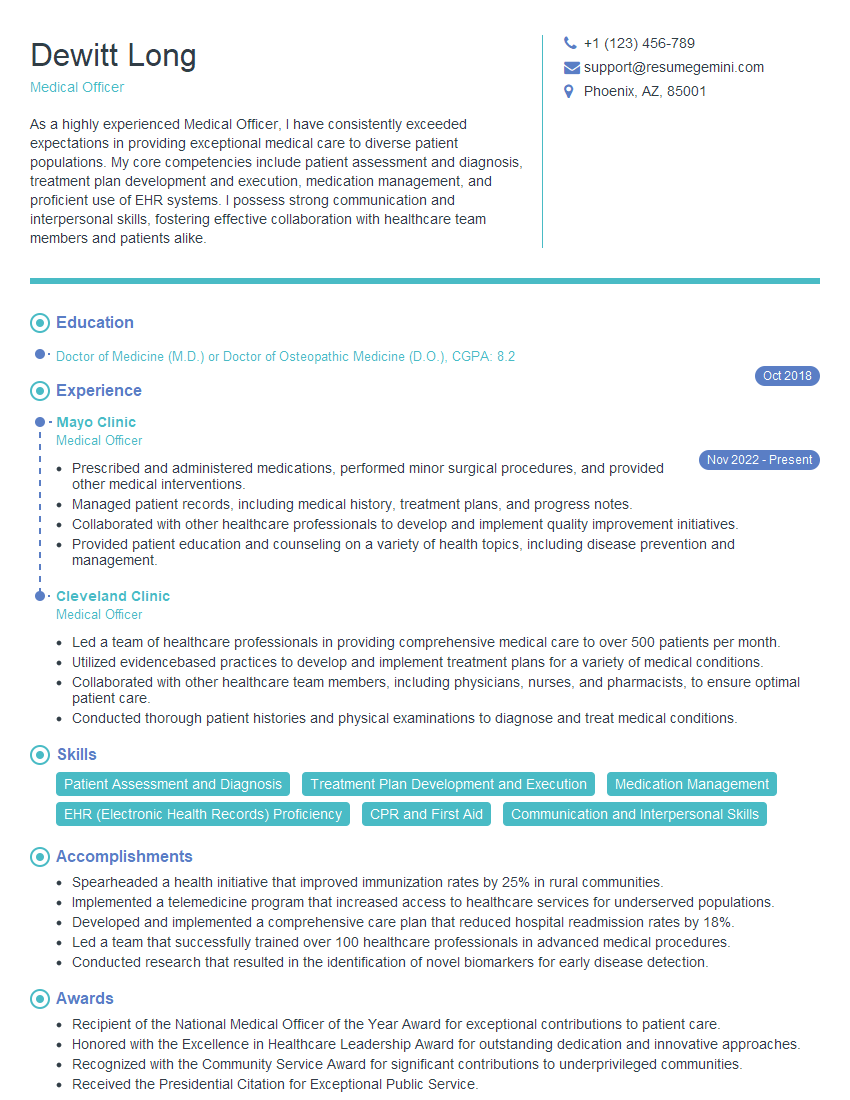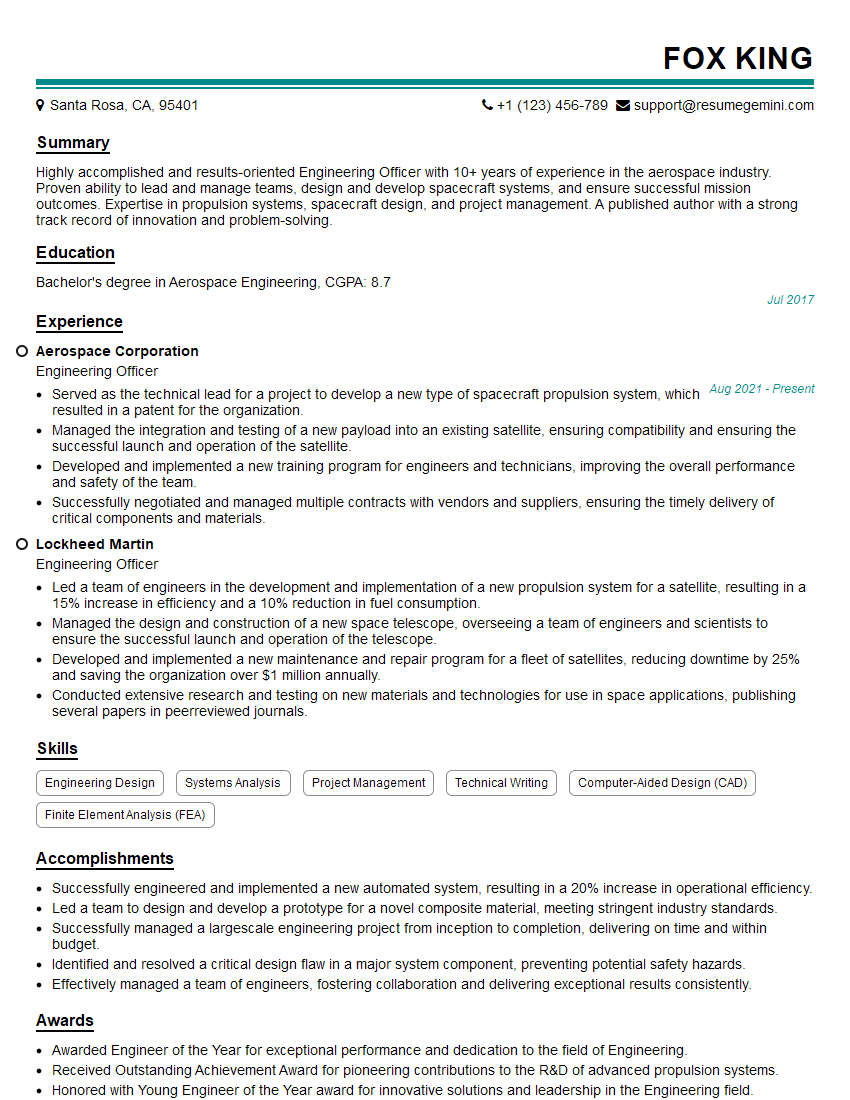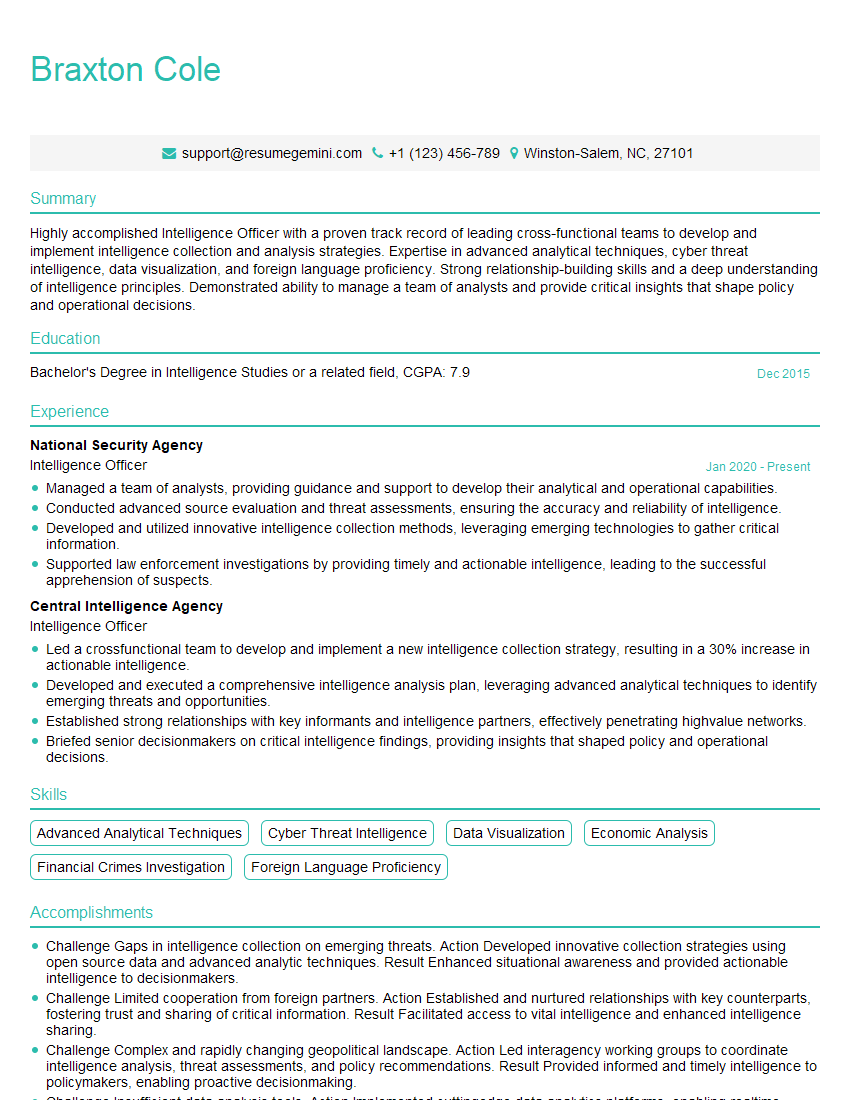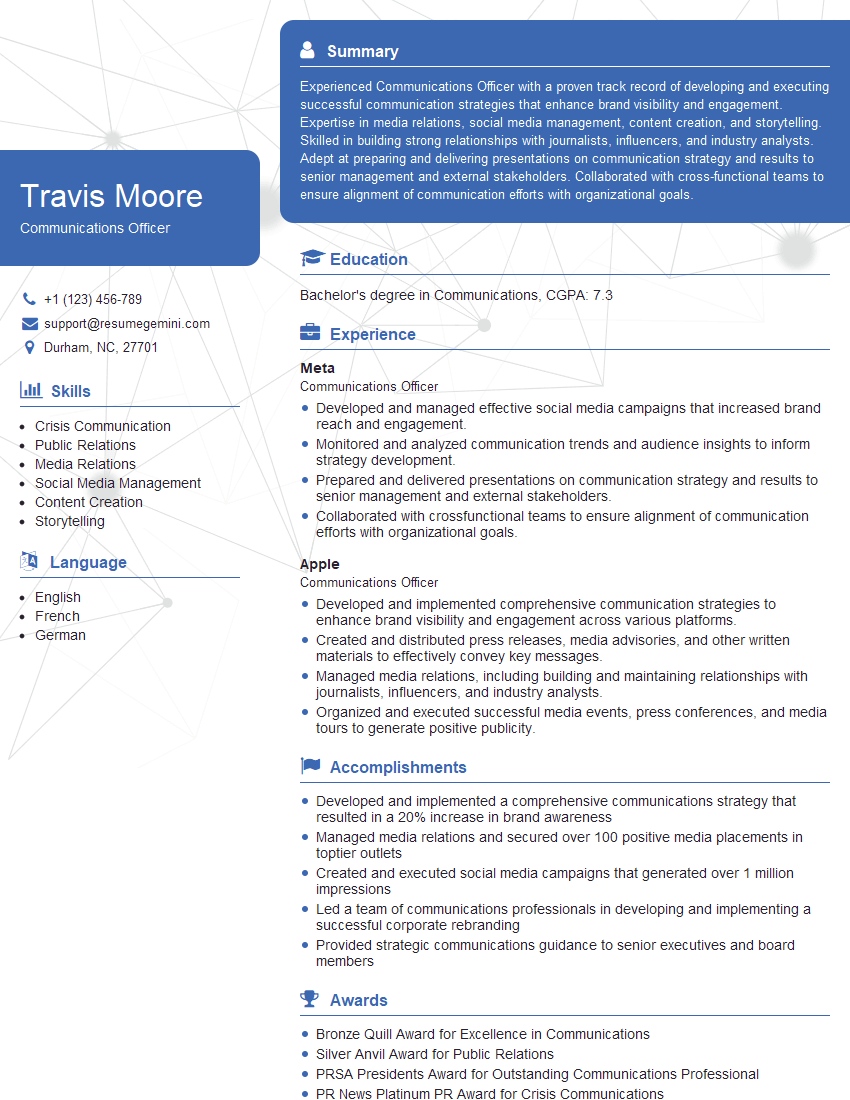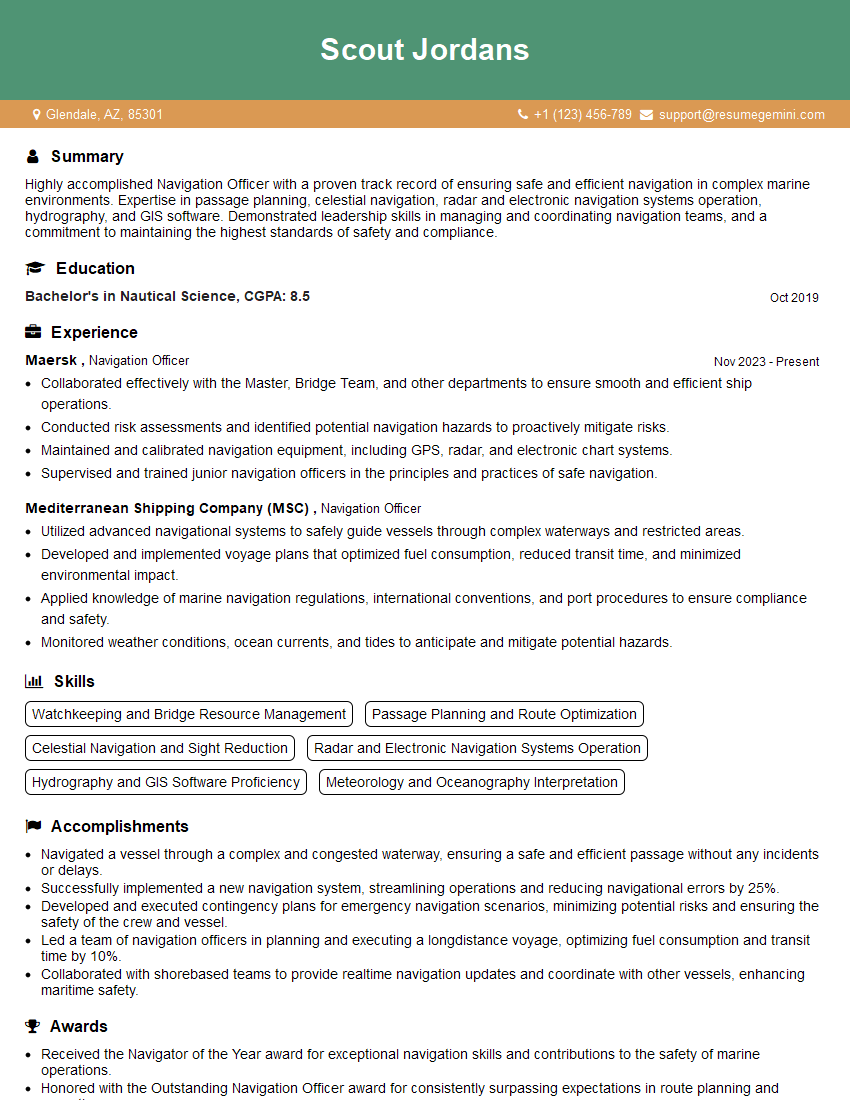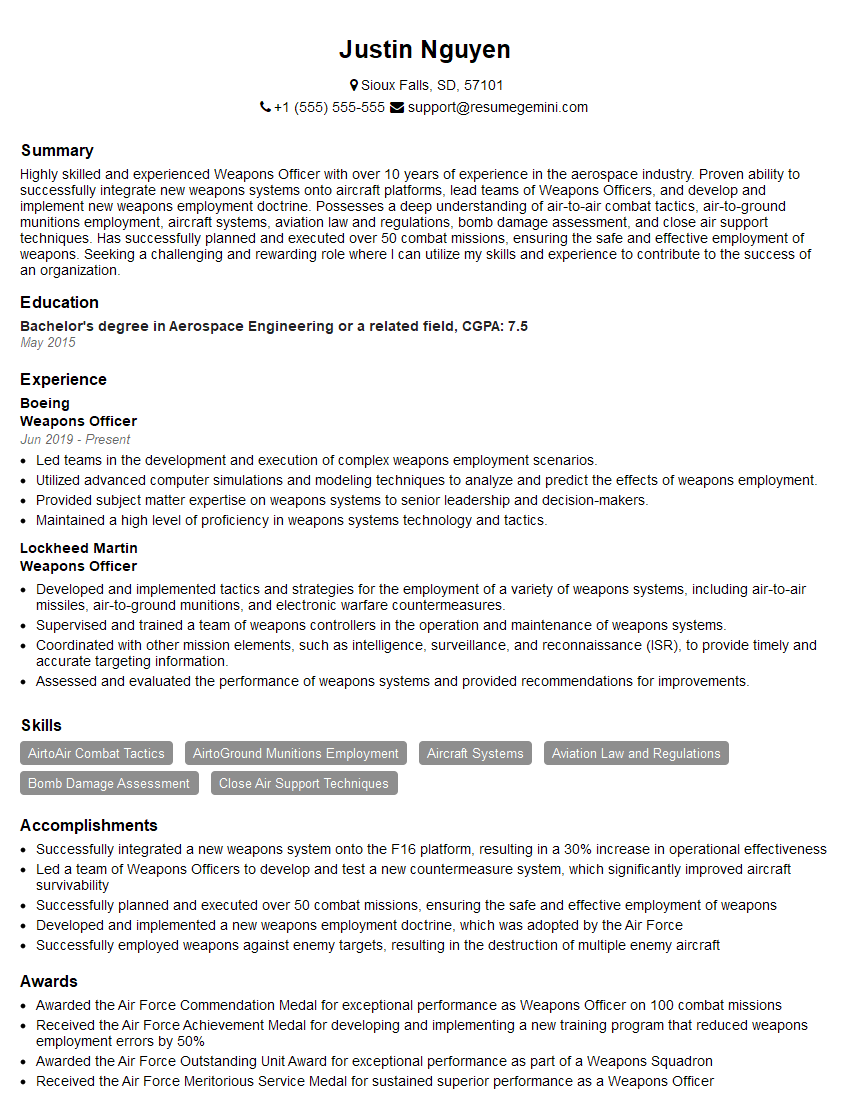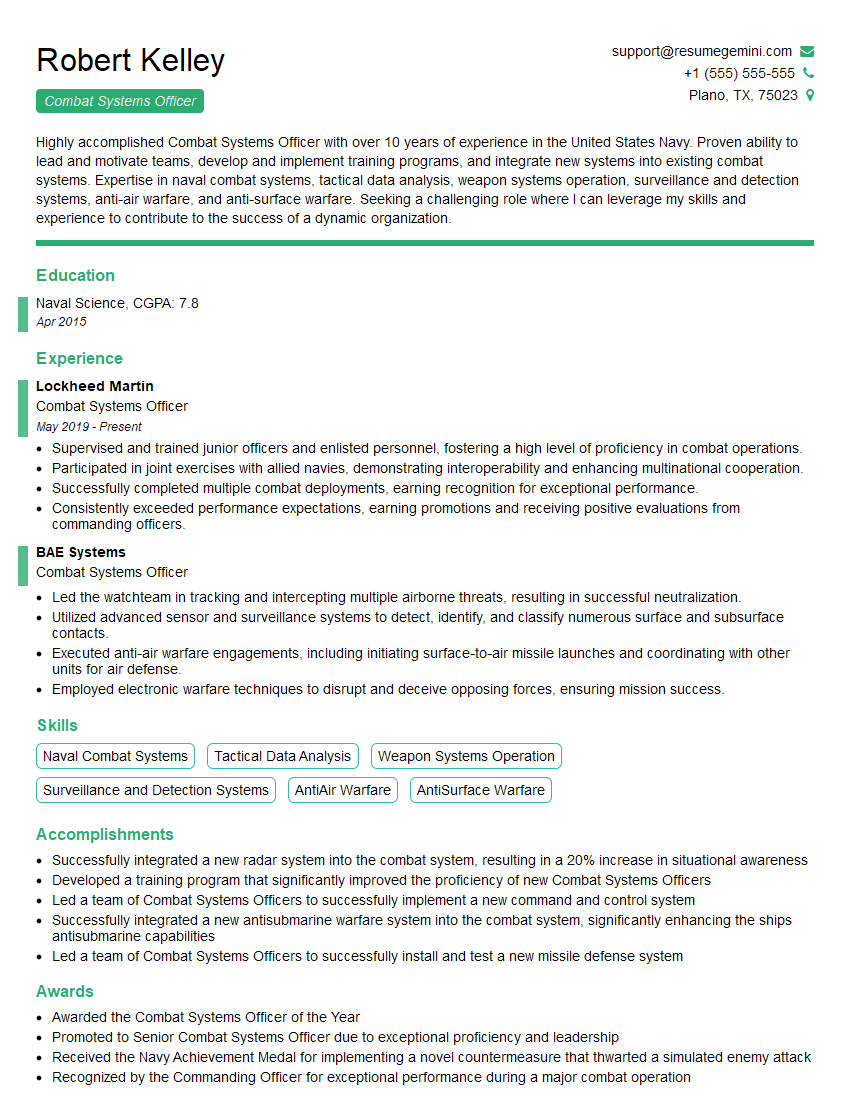Unlock your full potential by mastering the most common Naval Operations interview questions. This blog offers a deep dive into the critical topics, ensuring you’re not only prepared to answer but to excel. With these insights, you’ll approach your interview with clarity and confidence.
Questions Asked in Naval Operations Interview
Q 1. Explain the concept of ‘Naval Power Projection’.
Naval power projection is the ability of a navy to exert influence and project its military power far beyond its own shores. Think of it as extending a nation’s reach – its ability to respond to crises, deter aggression, or conduct operations globally. It’s not just about having a big fleet; it’s about the integrated capabilities – the ships, aircraft, submarines, Marines, logistics, and intelligence – that work together to achieve strategic goals. For example, a carrier strike group deploying to a region of instability projects power by demonstrating a nation’s resolve and ability to respond to threats, while simultaneously offering humanitarian assistance.
Effective power projection requires a robust logistical chain to sustain operations far from home bases, sophisticated communication networks for coordinated action, and strategic partnerships with other nations. The US Navy’s frequent deployments to the Pacific and the Mediterranean exemplify this; these deployments directly demonstrate US power and influence in those crucial regions.
Q 2. Describe the different types of naval vessels and their roles.
Naval vessels are incredibly diverse, each designed for specific roles. We can broadly categorize them:
- Aircraft Carriers: These are mobile air bases, providing air power far from land bases. Their role is projecting power, air superiority, and providing close air support.
- Cruisers and Destroyers: These are multi-mission warships, equipped with advanced sensors, missile systems, and anti-submarine capabilities. Their roles include fleet defense, anti-air warfare, and striking land targets.
- Submarines: These operate stealthily underwater, capable of conducting anti-submarine warfare, reconnaissance, and launching cruise missiles. Their primary role is often intelligence gathering and asymmetric warfare.
- Amphibious Assault Ships: These carry and deploy Marines and their equipment, supporting amphibious operations, humanitarian assistance, and disaster relief.
- Littoral Combat Ships (LCS): Designed for operations in shallow coastal waters, these vessels prioritize flexibility and adaptability to various missions, such as mine countermeasures and anti-submarine warfare.
- Support Ships: These provide essential logistical support to the fleet, including replenishment of fuel, ammunition, and supplies. Examples include oilers, repair ships, and hospital ships.
The specific roles often overlap and are highly dependent on technological advancements and evolving geopolitical circumstances.
Q 3. What are the key elements of a successful naval campaign?
A successful naval campaign relies on several key elements:
- Clear Objectives: Defined, achievable goals that align with overall strategic aims. A poorly defined objective will lead to a disjointed campaign.
- Sound Planning: Thorough assessment of the operational environment, enemy capabilities, and friendly forces, resulting in a well-coordinated plan.
- Effective Command and Control: Clear communication and decision-making processes across all levels of the chain of command.
- Superior Intelligence: Accurate, timely, and relevant intelligence to inform decision-making and anticipate enemy actions.
- Logistics and Sustainment: The ability to maintain a consistent flow of supplies, personnel, and support to naval forces throughout the campaign.
- Adaptability: The capacity to adjust plans and tactics in response to changing circumstances. Rigidity leads to failure.
- Interoperability: Seamless cooperation between different naval assets and allied forces.
The Gulf War’s naval campaign offers an excellent case study in successful planning and execution, demonstrating the importance of superior intelligence, decisive action, and integrated operations.
Q 4. How does naval intelligence contribute to operational planning?
Naval intelligence plays a crucial role in operational planning by providing a comprehensive understanding of the operational environment. This understanding includes the adversary’s capabilities, intentions, and vulnerabilities. Intelligence helps in:
- Target Identification and Prioritization: Pinpointing critical enemy assets and infrastructure to ensure maximum impact during operations.
- Risk Assessment: Identifying potential threats and vulnerabilities to friendly forces, helping to develop effective mitigation strategies.
- Force Deployment: Optimizing the deployment of naval assets to achieve maximum effect, considering enemy strengths and weaknesses.
- Predicting Enemy Actions: Anticipating enemy movements and strategies to enable proactive responses and avoid surprises.
- Assessing the Success of Operations: Evaluating the effectiveness of completed operations to refine future strategies and tactics.
Consider an amphibious landing: Naval intelligence would provide crucial information on coastal defenses, minefields, and enemy troop deployments, directly influencing the timing, location, and tactics of the landing.
Q 5. Outline the process of conducting a naval search and rescue operation.
A naval search and rescue (SAR) operation follows a structured process:
- Alert and Response: The initial notification of a distress signal triggers a coordinated response, often involving multiple agencies (Coast Guard, Navy, etc.).
- Search Planning: Determining the search area, using available information (last known position, vessel type, weather conditions) and employing specialized search patterns.
- Asset Deployment: Deploying appropriate assets, such as ships, aircraft, and helicopters, to cover the search area effectively.
- Search Execution: Conducting a systematic search using established patterns and techniques, utilizing radar, sonar, visual observation, and other detection methods.
- Rescue and Recovery: Locating and rescuing survivors, providing medical assistance, and recovering any remains or debris.
- Post-Rescue Actions: Documenting the operation, conducting post-mission analysis to improve future response, and providing support to survivors and their families.
Effective communication and coordination between participating agencies is paramount. The use of advanced technology, such as satellite communication and sophisticated search algorithms, plays a critical role in the success of these time-sensitive operations.
Q 6. Discuss the challenges of operating in littoral environments.
Operating in littoral environments (coastal regions) presents unique challenges:
- Complex Terrain: Navigating shallow waters, reefs, and obstacles requires specialized skills and equipment.
- Environmental Conditions: Varying weather conditions, currents, and tides can significantly impact operations.
- Limited Visibility: Restricted visibility due to shallow water and coastal features can hinder navigation and detection.
- Crowded Waterways: High traffic density from commercial and civilian vessels increases the risk of collisions and accidents.
- Asymmetric Threats: The proximity to land exposes naval forces to various asymmetric threats, such as mines, small boats, and coastal defenses.
Successful operations in littoral environments require careful planning, specialized equipment (e.g., mine countermeasures, littoral combat ships), and a high level of situational awareness. The US Navy’s experience in the Persian Gulf showcases the complexities and challenges of operating in these densely populated waterways.
Q 7. Explain the principles of naval logistics and supply chain management.
Naval logistics and supply chain management are crucial for sustaining naval operations, particularly for extended deployments far from home ports. The principles include:
- Predictive Planning: Accurately forecasting the needs of naval forces based on planned operations and potential contingencies.
- Efficient Transportation: Using a combination of sea, air, and land transportation methods to ensure timely delivery of supplies.
- Inventory Management: Maintaining optimal levels of supplies and equipment to meet operational demands, while avoiding excess inventory.
- Maintenance and Repair: Providing timely maintenance and repair services to keep naval vessels and equipment operational.
- Supply Chain Resilience: Building a robust and resilient supply chain that can withstand disruptions, such as natural disasters or geopolitical instability.
- Information Technology: Utilizing advanced information technology to track inventory, manage shipments, and ensure efficient communication.
Imagine a carrier strike group deployed for months; efficient logistics are vital for maintaining operational readiness. Without a well-managed supply chain, the group would quickly become incapable of carrying out its missions. The scale and complexity of naval logistics demand a highly structured and coordinated system.
Q 8. Describe the different types of naval warfare (e.g., anti-submarine, anti-surface).
Naval warfare encompasses a wide range of combat scenarios, each demanding specialized tactics and technologies. Let’s explore some key types:
- Anti-Submarine Warfare (ASW): This focuses on detecting, tracking, and destroying enemy submarines. It involves using various platforms like surface ships, aircraft, and submarines themselves, employing sonar, torpedoes, and depth charges. Think of it like a high-stakes game of hide-and-seek, where the submarine is trying to remain undetected while the ASW forces are using every tool to find it.
- Anti-Surface Warfare (ASuW): This involves engaging and neutralizing enemy surface ships. This can range from small patrol boats to large aircraft carriers, utilizing weapons like guided missiles, guns, and torpedoes. A classic example is a destroyer using long-range missiles to strike an enemy frigate.
- Anti-Air Warfare (AAW): This is about defending naval forces from air attacks. It employs surface-to-air missiles, anti-aircraft guns, and fighter aircraft to intercept incoming threats like bombers or missiles. Imagine a layered defense, with ships equipped with point defense systems protecting against close-range threats, while longer-range missiles take care of higher-altitude threats.
- Amphibious Warfare: This involves projecting power ashore, often in conjunction with land forces. It requires coordinated operations between ships, aircraft, and landing craft to transport and support troops in beach assaults and other operations. The D-Day landings in Normandy provide a prime example of the scale and complexity of amphibious warfare.
- Mine Warfare: This involves laying and neutralizing naval mines. Minesweeper ships are essential to clearing sea lanes of these underwater hazards. Think of these as booby traps protecting critical areas or port facilities.
- Electronic Warfare (EW): This entails employing electronic measures to disrupt enemy communications, radar systems and other electronic equipment. It is critical in ensuring information superiority and protecting own forces.
These types often overlap, and a modern naval engagement usually involves a combination of these warfare types. The ability to effectively coordinate these different aspects is crucial for success.
Q 9. How do you maintain communication and coordination during a complex naval operation?
Maintaining communication and coordination during complex naval operations is paramount. It relies on a robust, multi-layered system incorporating various technologies and protocols. Think of it like orchestrating a symphony, each instrument (ship, aircraft, etc.) playing its part harmoniously.
- Satellite Communications (SATCOM): Provides long-range, high-bandwidth communication, essential for transmitting data, images and voice across vast distances, even across oceans.
- High-Frequency (HF) Radio: Offers reliable communication over very long distances, especially useful in areas with limited satellite coverage.
- Ultra-High Frequency (UHF) Radio: Used for shorter-range, high-bandwidth communication between ships and aircraft.
- Link-16 Data Link: A tactical data link that allows near-real-time sharing of information, such as position, sensor data and targeting information, between multiple platforms. It’s like a shared battlefield awareness map, enhancing situational understanding.
- Data Fusion Centers: These combine data from multiple sources, creating a holistic view of the battlespace. The information they provide is critical for commanders to make informed decisions.
Regular communication drills and training are crucial in maintaining proficiency with these systems and ensuring effective communication flow under pressure. The use of standardized procedures and clear communication protocols minimize the risk of misinterpretations.
Q 10. What are the ethical considerations in naval warfare?
Ethical considerations in naval warfare are complex and demand careful attention. The principles of Just War Theory provide a valuable framework. Essentially, before engaging in war, all possible options for peace must be exhausted. The use of force should be proportionate to the threat. Additionally, it is essential to distinguish between combatants and civilians.
- Proportionality: The force used should be proportionate to the military objective. Unnecessary destruction or civilian harm should be avoided at all costs.
- Distinction: Clearly distinguishing between military targets and civilians is paramount. Targeting civilian infrastructure or intentionally harming civilians is prohibited.
- Military Necessity: Actions must be necessary to achieve a legitimate military objective.
- Humanitarian Law: Adherence to international humanitarian law, including the Geneva Conventions, is critical in protecting the rights of prisoners of war and civilians.
- Accountability: Those who violate these principles must be held accountable for their actions.
Ethical considerations must guide every aspect of naval operations, from target selection to the treatment of prisoners of war. These principles are not merely suggestions but binding obligations under international law.
Q 11. Explain the importance of damage control in naval operations.
Damage control in naval operations is critical for maintaining the operational effectiveness and survivability of a vessel. It encompasses the immediate response and repair efforts following any damage incurred, preventing further damage or loss of life.
Imagine a ship sustaining damage in a battle: a fire erupts, flooding occurs, or structural damage is inflicted. The damage control team must immediately act to contain the damage, prevent further spread, and restore operational capabilities to the best extent possible. This includes:
- Firefighting: Using various extinguishing systems to prevent the spread of fire.
- Flood Control: Securing damaged compartments, pumping out water, and controlling flooding.
- Structural Repairs: Patching holes and stabilizing damaged areas to prevent further structural degradation.
- Casualty Care: Providing first aid and medical care to injured personnel.
- Damage Assessment: Determining the extent of damage and prioritization of repairs.
Regular drills and training are crucial to ensuring the damage control team’s effectiveness. This reduces response times, increasing the ship’s chances of survival and continuing the mission.
Q 12. Describe your understanding of naval command structures and authority.
Naval command structures are hierarchical, built on a clear chain of command to ensure efficient decision-making and coordination. Authority flows from the top down, with clear lines of responsibility at each level.
At the highest level is the Commander-in-Chief (CIN) of a fleet or naval force. Beneath them are subordinate commanders, leading different formations or ships. Each ship has its own commanding officer (CO), who is ultimately responsible for the ship and its crew. On a larger scale, a Carrier Strike Group might be led by a Carrier Strike Group Commander (CSG CDR), who has overall control over multiple ships, submarines and aircraft.
Authority is clearly defined, with each commander having specific responsibilities and decision-making authority within their purview. This hierarchical structure ensures clear lines of responsibility and effective coordination, but it also encourages initiative and decentralized decision-making when appropriate. Effective communication and collaboration are key to making this system work effectively.
Q 13. How would you handle a crisis situation onboard a naval vessel?
Handling a crisis situation onboard a naval vessel requires a calm, decisive, and methodical approach. It’s essential to prioritize safety, maintain control, and implement established procedures.
A step-by-step approach would look like this:
- Assessment: Quickly assess the nature and extent of the crisis. This involves gathering information from various sources, including personnel on the scene, sensors and communication systems.
- Prioritization: Prioritize actions based on the most immediate threats to safety and mission. For example, fire control might take precedence over minor flooding.
- Action: Implement established damage control procedures, emergency plans, and crisis management protocols. This often involves delegating tasks to appropriate personnel and utilizing available resources.
- Communication: Maintain clear, concise, and continuous communication with all relevant personnel, superior commanders, and potentially shore-based support.
- Documentation: Thoroughly document all actions taken, including decisions made, personnel involved, and observations. This is critical for post-incident analysis and learning.
Regular training, drills, and simulations are crucial to ensuring the crew is prepared to respond effectively to a wide range of crises.
Q 14. Explain the principles of naval navigation.
Naval navigation relies on a combination of traditional and modern techniques to determine a ship’s position, course, and speed, and to safely navigate through various waters.
- Celestial Navigation: While less common now, this uses the positions of stars and planets to determine a ship’s latitude and longitude. It’s a valuable backup system when other technologies fail.
- Electronic Navigation: This relies on electronic systems such as Global Positioning System (GPS), radar, and electronic charts (ECDIS). GPS provides highly accurate position data, while radar assists in detecting obstacles and other vessels. ECDIS combines electronic charts with data from other navigation systems to present a comprehensive navigation picture.
- Piloting: This involves using visual references such as landmarks, buoys, and lights to navigate in coastal waters or confined areas. It is particularly useful in areas with limited GPS coverage or when high accuracy is needed.
- Dead Reckoning: This is a calculation of the ship’s position based on its initial position, course, and speed. It’s a backup method, used in conjunction with other navigation methods to provide redundancy.
Effective naval navigation requires a thorough understanding of these different methods, along with knowledge of nautical charts, navigational publications, and maritime regulations. Professional training and certifications are crucial for safe and effective operation.
Q 15. Discuss the role of technology in modern naval operations.
Technology has revolutionized modern naval operations, impacting every facet from intelligence gathering to combat execution. It’s no longer just about bigger guns; it’s about integrated systems and superior information dominance.
Intelligence, Surveillance, and Reconnaissance (ISR): Unmanned Aerial Vehicles (UAVs) like drones provide real-time intelligence, significantly enhancing situational awareness. Satellites provide imagery and communication capabilities across vast ocean expanses. Sophisticated sensor fusion systems integrate data from multiple sources for a comprehensive picture.
Command and Control (C2): Advanced communication networks allow for seamless information sharing across fleets, enabling coordinated actions and faster decision-making. This includes secure satellite communication and high-bandwidth data links.
Weapons Systems: Precision-guided munitions, advanced radar systems, and automated targeting systems dramatically increase accuracy and lethality while minimizing collateral damage. Examples include Aegis Combat Systems and various cruise missile systems.
Cybersecurity: Protecting naval networks and systems from cyberattacks is critical. This includes investing in robust cybersecurity infrastructure and training personnel to identify and respond to threats.
Navigation and Positioning: GPS and other satellite-based navigation systems provide precise positioning and are vital for safe and efficient navigation. However, the development of anti-GPS technologies demands robust fallback systems.
For example, during a recent anti-piracy operation, our fleet used UAVs to locate a suspected pirate vessel. The data, integrated with satellite imagery and intelligence reports, enabled a swift and precise response, leading to a successful apprehension without any casualties.
Career Expert Tips:
- Ace those interviews! Prepare effectively by reviewing the Top 50 Most Common Interview Questions on ResumeGemini.
- Navigate your job search with confidence! Explore a wide range of Career Tips on ResumeGemini. Learn about common challenges and recommendations to overcome them.
- Craft the perfect resume! Master the Art of Resume Writing with ResumeGemini’s guide. Showcase your unique qualifications and achievements effectively.
- Don’t miss out on holiday savings! Build your dream resume with ResumeGemini’s ATS optimized templates.
Q 16. What is your understanding of international maritime law?
International maritime law, primarily governed by the United Nations Convention on the Law of the Sea (UNCLOS), establishes a framework for regulating activities on the world’s oceans. It defines maritime zones, navigation rights, resource exploitation, and the responsibilities of states in maintaining maritime security.
Territorial Waters: A coastal state has sovereignty over its territorial waters (generally 12 nautical miles from its baseline).
Exclusive Economic Zone (EEZ): Extending up to 200 nautical miles from the baseline, this zone grants coastal states sovereign rights over the exploration and use of marine resources.
High Seas: Areas beyond national jurisdiction, governed by principles of freedom of navigation, fishing, and overflight. However, this freedom is not absolute and must be exercised responsibly and in accordance with other provisions of UNCLOS.
Maritime Security: UNCLOS obliges states to cooperate in combating threats like piracy, smuggling, and terrorism at sea. This involves joint patrols, information sharing, and the pursuit of offenders within the relevant legal framework.
Understanding UNCLOS is crucial for naval operations. For instance, when conducting exercises or deployments near foreign coasts, strict adherence to territorial boundaries and navigational rights is essential to avoid international incidents. Navigating the complexities of UNCLOS requires specialized legal expertise within the naval command structure.
Q 17. How do you assess and mitigate risks in naval operations?
Risk assessment and mitigation in naval operations is a continuous process involving a multi-faceted approach. It starts with identifying potential hazards, analyzing their likelihood and impact, and implementing measures to reduce or eliminate them.
Hazard Identification: This encompasses a wide range of threats, from natural events (storms, earthquakes) to human factors (equipment malfunction, human error), adversary actions (attacks, sabotage) and environmental factors.
Risk Analysis: Assessing the likelihood and potential consequences of each identified hazard is done using various methodologies, often involving quantitative and qualitative analysis.
Mitigation Strategies: Once risks are identified and assessed, mitigation strategies are implemented. These strategies can include redundancy in equipment, training and drills, enhanced communication protocols, strengthened security measures, and operational changes.
Contingency Planning: Having well-developed plans for various emergency scenarios is crucial. These plans outline procedures for responding to specific situations and minimize negative consequences.
Continuous Monitoring and Review: The effectiveness of risk management is continuously monitored and evaluated. The process is iterative, adapting to changing circumstances and lessons learned from past experiences.
For instance, before a deployment to a high-risk area, we conduct a thorough risk assessment considering potential threats like piracy and enemy activity. This assessment informs decisions about force composition, operational procedures, and security measures, including armed guards and defensive tactics.
Q 18. Describe your experience with naval planning and execution.
My experience in naval planning and execution spans various operational scales, from small-unit tactical operations to large-scale joint exercises. The process typically involves several key phases:
Planning Phase: This includes defining objectives, analyzing the operational environment, developing courses of action (COAs), allocating resources, and conducting risk assessments.
Execution Phase: This involves putting the plan into action, monitoring progress, adapting to changing circumstances, and making real-time adjustments as needed.
Post-Execution Phase: This is crucial for lessons learned, including analyzing successes and failures, identifying areas for improvement, and incorporating feedback into future plans.
In one particular instance, I was responsible for planning and executing a complex amphibious landing exercise. This involved coordinating multiple units, including ships, aircraft, and ground forces, to achieve a specific objective. Through meticulous planning, careful coordination, and effective communication, the exercise was successfully completed, demonstrating the importance of collaboration and adaptability.
Q 19. How do you manage personnel effectively in a naval environment?
Effective personnel management in a naval environment requires a multi-pronged approach focusing on training, welfare, and leadership. The unique demands of naval service, including extended deployments and challenging conditions, necessitate a tailored approach to human resource management.
Training and Development: Providing continuous training and development opportunities ensures personnel are proficient in their roles and prepared for future challenges. This includes both technical training and leadership development programs.
Welfare and Support: Addressing the physical and mental well-being of personnel is paramount. This involves providing access to healthcare, counseling services, and recreational activities, particularly during long deployments.
Leadership and Motivation: Strong leadership is essential in fostering a cohesive team environment. This involves creating a culture of trust, mutual respect, and clear communication, ensuring clear roles, responsibilities, and expectations.
Discipline and Accountability: Maintaining high standards of discipline and accountability is vital for operational effectiveness and safety. This includes clear guidelines and fair enforcement of regulations.
I’ve seen firsthand the importance of fostering a positive and supportive work environment. By empowering personnel, recognizing their contributions, and addressing their concerns promptly, we can build strong teams capable of accomplishing demanding missions successfully.
Q 20. What are the key performance indicators (KPIs) in naval operations?
Key Performance Indicators (KPIs) in naval operations vary depending on the specific mission and operational context, but generally focus on effectiveness, efficiency, and safety. Examples include:
Mission Success Rate: The percentage of missions completed successfully, achieving their stated objectives.
Operational Readiness Rate: The percentage of equipment and personnel ready for deployment at any given time.
Personnel Safety Record: The number of accidents, injuries, and fatalities per unit or operation.
Logistics Efficiency: Measures of the effectiveness and efficiency of supplying and supporting naval forces at sea.
Cost-Effectiveness: The relationship between mission accomplishment and the resources expended.
Cybersecurity Incident Rate: The number of successful cyberattacks against naval systems and networks.
These KPIs are tracked and analyzed to identify areas for improvement and to ensure resources are allocated effectively. Regular monitoring and evaluation of KPIs are vital for continuous improvement of naval operations.
Q 21. Explain the concept of ‘command and control’ in naval operations.
Command and control (C2) in naval operations refers to the exercise of authority and direction by a commander over subordinate forces to accomplish a mission. It’s a complex process involving communication, decision-making, and coordination of diverse assets across potentially vast distances.
Communication: Seamless communication is the foundation of effective C2. Modern naval forces rely on advanced communication networks, including satellite communication, high-frequency radio, and data links.
Decision-Making: Commanders must make timely and informed decisions based on available information. This involves analyzing the operational environment, assessing risks, and selecting the best course of action.
Coordination: Effectively coordinating the actions of multiple units, often operating across different domains (air, sea, land), is crucial for achieving objectives. This involves establishing clear chains of command and implementing effective coordination mechanisms.
Information Management: Managing the flow of information is essential. This includes collecting, processing, and disseminating information to the relevant personnel in a timely and efficient manner. A battle management system helps to centralize this critical process.
A successful C2 system enables commanders to maintain situational awareness, make informed decisions, and coordinate forces effectively, maximizing operational effectiveness and mission success. Failures in C2 can have dire consequences, highlighting the importance of robust systems and well-trained personnel.
Q 22. Describe your experience with naval training and exercises.
My naval training encompassed a rigorous curriculum covering seamanship, navigation, weapons systems, damage control, and leadership. Initial training focused on foundational skills, progressing to specialized training in anti-submarine warfare (ASW). Exercises ranged from basic ship handling drills, such as man overboard and fire-fighting, to complex multi-ship scenarios involving air defense, anti-surface warfare (ASuW), and amphibious operations. For example, during a UNITAS exercise, we participated in a large-scale multinational operation, integrating with forces from several South American nations to improve interoperability and tactical proficiency in a simulated hostile environment. The experience honed my ability to work under pressure and within a highly structured chain of command.
Beyond formal training, I’ve actively sought opportunities for advanced education. I’ve completed courses in strategic naval planning, command and control, and information warfare. These courses provided a deeper understanding of the operational environment and strategic considerations vital for effective naval leadership.
Q 23. How do you ensure the safety of personnel and equipment during operations?
Ensuring the safety of personnel and equipment during naval operations is paramount. This involves a multi-layered approach. Firstly, rigorous adherence to established safety protocols and standard operating procedures (SOPs) is crucial. This includes regular safety inspections, pre-operation checks, and risk assessments. Think of it like pre-flight checklists for an aircraft; every detail is critical. Secondly, effective communication and teamwork are vital. Clear and concise orders, coupled with the ability to adapt to unexpected events, reduce errors and mitigate risks. For instance, during a heavy storm at sea, clear communication between the bridge and engine room was vital in preventing equipment damage and ensuring the vessel’s stability.
Thirdly, continuous training and proficiency maintenance are key to preventing accidents. Regular drills and exercises for emergency situations like fire, flooding, and man overboard ensure crews react effectively. Finally, a strong safety culture is essential, where personnel feel empowered to report hazards and concerns without fear of reprisal. In my experience, fostering a proactive safety culture through open communication and a shared commitment to safety has been instrumental in maintaining a safe working environment.
Q 24. What is your understanding of the different types of naval deployments?
Naval deployments vary significantly in scope, duration, and objective. Broadly, they can be categorized as follows:
- Power Projection Deployments: These involve sending naval forces to a region to demonstrate military strength and influence, often as a deterrent to aggression. An example would be a carrier strike group deployed near a zone of conflict.
- Peacekeeping Operations: Naval forces are deployed to support UN or other international peacekeeping missions. This might involve monitoring ceasefires, providing humanitarian assistance, or enforcing sanctions.
- Humanitarian Assistance/Disaster Relief (HA/DR): In response to natural disasters, naval assets provide vital support, offering medical aid, supplies, and evacuation capabilities. The response to the 2004 Indian Ocean tsunami exemplifies this type of deployment.
- Training Deployments: These aim to enhance interoperability with allied nations, conduct joint exercises, or provide training to local forces. Many multinational exercises, like RIMPAC, fall under this category.
- Anti-Piracy Operations: Deployments focused on protecting shipping lanes and commercial vessels from pirate attacks in high-risk areas. This type of deployment often involves close cooperation with international partners.
Each deployment type has specific operational requirements, logistical considerations, and force composition. Planning and execution must account for these unique aspects to ensure mission success.
Q 25. Explain the concept of ‘sea control’ and its importance.
Sea control refers to a navy’s ability to prevent an enemy from using the sea to its advantage. It’s not simply about winning battles; it’s about dominating a maritime area to such an extent that an adversary’s operations are severely hampered. This involves controlling surface waters, the undersea environment (anti-submarine warfare), and the airspace above. Think of it as controlling the three-dimensional battlespace at sea.
The importance of sea control cannot be overstated. It’s fundamental to projecting power, securing lines of communication (SLOCs), and supporting amphibious operations. Control of the sea allows for the free movement of friendly forces, the denial of maritime access to adversaries, and the protection of vital seaborne trade. Historically, control of the sea has been a decisive factor in many wars, determining access to resources, reinforcing alliances, and dictating strategic advantage.
Achieving sea control requires a combination of factors: a strong and versatile navy, robust intelligence, effective command and control, and the ability to sustain operations over extended periods. In the modern context, information warfare and cyber warfare play increasingly significant roles in establishing and maintaining sea control.
Q 26. Describe your understanding of naval doctrine.
Naval doctrine is a set of formally codified beliefs, principles, and practices that guide the actions of a navy. It defines how a navy organizes, trains, equips, and employs its forces to achieve strategic and operational objectives. It encompasses everything from the overall strategic vision to tactical procedures for individual ships and aircraft. For example, a nation’s naval doctrine might emphasize offensive operations with aircraft carriers, or it may prioritize submarine warfare and anti-access/area denial strategies.
Naval doctrine isn’t static; it evolves in response to technological advancements, geopolitical shifts, and lessons learned from past conflicts. Analysis of past conflicts, technological advancements, and potential adversaries heavily influence these changes. Understanding the doctrinal principles of an adversary is vital in predicting their likely course of action and preparing appropriate countermeasures. My understanding of naval doctrine informs my approach to strategic planning, operational decision-making, and leadership in a naval context.
Q 27. How do you maintain morale and cohesion within a naval crew?
Maintaining morale and cohesion within a naval crew is crucial for operational effectiveness and overall well-being. This requires a multi-faceted approach. First, leadership plays a critical role. Fairness, open communication, and effective delegation of tasks are key to fostering trust and respect. Leaders should demonstrate concern for the welfare of their crew and ensure that grievances are addressed promptly and effectively.
Secondly, providing opportunities for recreation and social interaction is essential. This could involve organizing shipboard activities, providing access to entertainment, and ensuring adequate rest periods. In long deployments, maintaining morale can be more challenging, so proactive measures to ensure crew well-being are critical. For instance, regular communication with families and access to online communication are vital.
Thirdly, a strong sense of shared purpose and mission accomplishment is essential. Clearly articulating the importance of the mission, celebrating successes, and acknowledging individual contributions can reinforce group identity and collective pride. Finally, establishing effective communication channels, both formal and informal, ensures that issues are addressed proactively, preventing minor problems from escalating into larger morale problems.
Key Topics to Learn for Naval Operations Interview
- Naval Strategy & Doctrine: Understanding core principles of naval power projection, maritime security, and operational planning. Consider the interplay of political, economic, and military factors.
- Maritime Warfare: Familiarize yourself with various types of naval warfare (anti-submarine, surface, air) and the technologies employed. Think critically about the limitations and capabilities of different weapon systems and platforms.
- Logistics & Supply Chain Management in Naval Operations: Explore the challenges of maintaining a global naval presence, including fuel, personnel, and equipment replenishment. Consider how logistical efficiency impacts operational effectiveness.
- Command & Control: Understand the decision-making processes within naval hierarchies, communication protocols, and the importance of clear and concise orders under pressure. Analyze potential communication breakdowns and their consequences.
- Intelligence, Surveillance, and Reconnaissance (ISR): Explore the role of ISR in naval operations, including information gathering, analysis, and its use in shaping strategic and tactical decisions. Consider the ethical implications of intelligence gathering.
- Cybersecurity in Naval Operations: Understand the vulnerabilities of naval systems to cyberattacks and the importance of robust cybersecurity measures to protect sensitive information and critical infrastructure.
- International Law of the Sea (UNCLOS): Familiarize yourself with the legal framework governing maritime operations, including territorial waters, exclusive economic zones, and the rights and responsibilities of naval forces in international waters.
- Problem-Solving & Decision-Making under Pressure: Practice analyzing complex scenarios, identifying key issues, and formulating effective solutions under time constraints and uncertainty. Develop your ability to explain your reasoning clearly and concisely.
Next Steps
Mastering Naval Operations principles is crucial for career advancement within the field, opening doors to leadership roles and specialized assignments. A strong resume is your first impression—ensure it’s ATS-friendly to maximize your chances of landing an interview. To build a compelling and effective resume tailored to the specific demands of Naval Operations, we highly recommend leveraging ResumeGemini. ResumeGemini offers a streamlined process for creating professional, impactful resumes, and we provide examples specifically designed for Naval Operations candidates to help you get started.
Explore more articles
Users Rating of Our Blogs
Share Your Experience
We value your feedback! Please rate our content and share your thoughts (optional).
What Readers Say About Our Blog
Hello,
We found issues with your domain’s email setup that may be sending your messages to spam or blocking them completely. InboxShield Mini shows you how to fix it in minutes — no tech skills required.
Scan your domain now for details: https://inboxshield-mini.com/
— Adam @ InboxShield Mini
Reply STOP to unsubscribe
Hi, are you owner of interviewgemini.com? What if I told you I could help you find extra time in your schedule, reconnect with leads you didn’t even realize you missed, and bring in more “I want to work with you” conversations, without increasing your ad spend or hiring a full-time employee?
All with a flexible, budget-friendly service that could easily pay for itself. Sounds good?
Would it be nice to jump on a quick 10-minute call so I can show you exactly how we make this work?
Best,
Hapei
Marketing Director
Hey, I know you’re the owner of interviewgemini.com. I’ll be quick.
Fundraising for your business is tough and time-consuming. We make it easier by guaranteeing two private investor meetings each month, for six months. No demos, no pitch events – just direct introductions to active investors matched to your startup.
If youR17;re raising, this could help you build real momentum. Want me to send more info?
Hi, I represent an SEO company that specialises in getting you AI citations and higher rankings on Google. I’d like to offer you a 100% free SEO audit for your website. Would you be interested?
Hi, I represent an SEO company that specialises in getting you AI citations and higher rankings on Google. I’d like to offer you a 100% free SEO audit for your website. Would you be interested?
good
